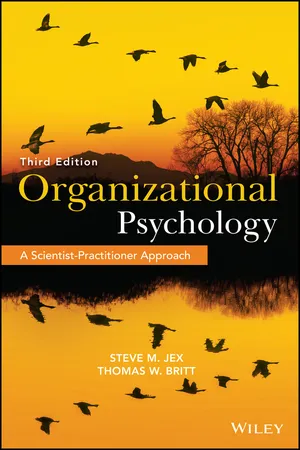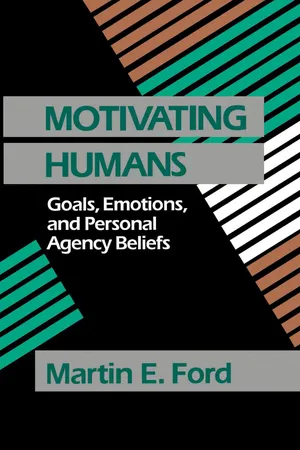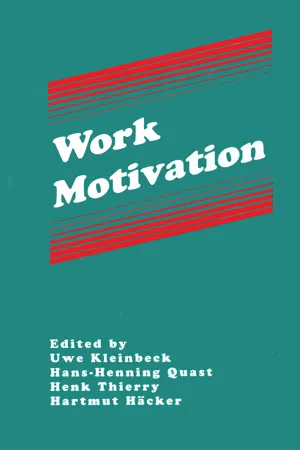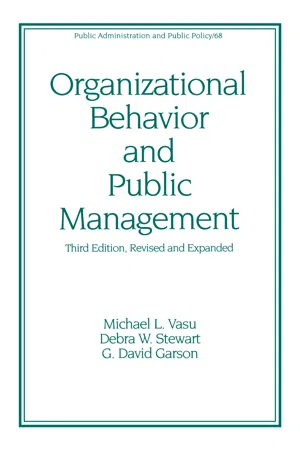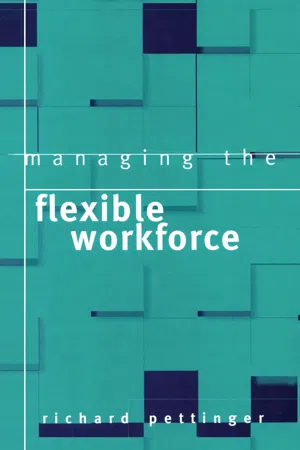Business
Integrating Theories of Motivation
Integrating theories of motivation involves combining different psychological perspectives to understand and enhance employee motivation. This approach draws on theories such as Maslow's hierarchy of needs, Herzberg's two-factor theory, and expectancy theory to create a comprehensive understanding of what drives individuals in the workplace. By integrating these theories, businesses can develop more effective strategies for motivating their employees.
Written by Perlego with AI-assistance
Related key terms
Related key terms
1 of 4
Related key terms
1 of 3
10 Key excerpts on "Integrating Theories of Motivation"
- eBook - ePub
Performance Management Systems
A Global Perspective
- Arup Varma, Pawan S. Budhwar, Angelo DeNisi(Authors)
- 2023(Publication Date)
- Routledge(Publisher)
First, one will be more motivated to put forth effort if they believe that they can achieve high performance through hard work. A range of factors may contribute to employees’ expectancy perceptions, including employees’ abilities, skills, knowledge, the support and resources that they have access to, and personality traits, including self-efficacy and locus of control. For instance, when an employee is assigned a task that is far beyond their ability, their motivation level will suffer because they think they will not be able to complete the task no matter how hard they try. Or, if an employee lacks the necessary resources or equipment tools to achieve high performance, they may simply withhold their effort. Similarly, when an employee has an external locus of control (i.e., a general expectancy that performance is dependent on uncontrollable factors such as luck), or low self-efficacy (i.e., not confident in their ability), expectancy is likely to be low. Thus, organizations wishing to strengthen employees’ expectancy perceptions can benefit from a variety of practices, such as delegating tasks with moderate difficulty levels, providing continuous feedback to help employees improve their performance, and offering training opportunities to improve their knowledge and skills. Apart from expectancy, one will be motivated to put more effort when they believe high performance will lead to rewards. As such, it is important for organizations to link rewards to performance and make sure employees are aware of the connections. Finally, employees are more likely to be motivated when the rewards associated with high performance are personally attractive. If a high-performing employee values work–life balance and hopes to get a weeklong paid vacation but the organization rewarded them with more responsibilities and authority instead, this employee might find the reward undesirable (i.e., the valence is negative) and might withhold efforts in the future. Therefore, managers are advised to find out what their employees value via surveying them or talking to them directly. It might also be a good idea if employees have the option to choose the rewards that appeal to them among several equivalent ones.To summarize, the basic premise of process-based theories of work motivation is that employee motivation is a rational process – employees cognitively process their surrounding environment, and react in certain ways to maximize the expected payoff. It is worth noting that equity theory and expectancy theory are particularly useful to help organizations motivate employees through performance management.Goal-Based Theories of Work Motivation
A goal represents something that an individual attempts to attain or achieve; it is the aim of an individual’s behavior (Locke & Latham, 2002 ). Goal-setting theory (Locke & Latham, 1990 , 2002 ) is one of the most important and influential theories of work motivation, which has received numerous empirical supports across employees from varied industries (Miner, 2003 ). The fundamental tenet of this theory is that goals guide human behavior. There is strong support that, in the workplace, setting appropriate goals can help enhance employee performance to a large extent (Latham & Locke, 2006 ; Pritchard, Roth, Jones, Galgay, & Watson, 1988 ).The second major tenet of goal-setting theory is that challenging or difficult goals lead to higher levels of performance than easy goals. Meta-analytic evidence shows that when goals are challenging and aggressive, employees tend to work harder or smarter, leading to higher levels of both individual and group performance (Kleingeld, van Mierlo, & Arends, 2011 ; Steel & Karren, 1987 ). At first glance, the goal difficulty tenet of goal-setting theory is contradictory to expectancy theory; the latter seems to suggest that easy goals can enhance employees’ expectancy perception, resulting in higher levels of motivation. To solve this apparent contradiction, Locke and Latham (2002) - eBook - ePub
Performance Management
Measure and Improve The Effectiveness of Your Employees
- (Author)
- 0(Publication Date)
- Harvard Business Review Press(Publisher)
2Motivation
The Not-So-Secret Ingredient of High PerformanceKey Topics Covered in This Chapter- Theories of motivation
- Intrinsic and extrinsic rewards
- The messy problem of incentive systems
- Ten motivational practices
M OTIVATION IS THE next important piece of managing employee performance. It is, in fact, at the very heart of performance management—something that managers must attend to all the time. A person can understand goals and why they are important, but must also be motivated to pursue them. You can coach this same person to close performance gaps and improve productivity, but the employee won’t take that coaching to heart if he or she is uninterested or unmotivated. You can spend hours on someone’s annual performance appraisal and have a productive chat about it, but again, those hours will be wasted if the employee isn’t motivated to improve.This chapter explains some of the key theories of workplace motivation and the impact of rewards and incentives. It offers a number of things you can do to motivate the people who work for you.Theories of Motivation
The principles of effective motivation have a long history. Although we tend to mark the beginning of that history with the Industrial Age, leaders and managers of every age undoubtedly understood the importance of motivation and probably experimented with different ways of inspiring it.The classic theories of industrial management and organization were formulated in the late 1800s and early 1900s. These theories were less concerned with worker motivation than with the mechanisms of efficiency, predictability, and control. A business was conceptualized as a machine for producing goods and services, and people were simply among the parts of that machine. Frederick Taylor (1856–1915), credited as the father of scientific management, defined work in terms of coordinated, highly specified tasks designed for optimal efficiency, with little or nothing left to the judgment of production-line employees. This approach to work was supported by a particular view of human nature—or, should we say, the nature of industrial workers. In this view, employees were lazy and untrustworthy creatures. They could be motivated only by pay and the fear of dismissal and unemployment. Years later, Douglas McGregor would enshrine this view of human nature in what he called the Theory X approach to management.1 - eBook - ePub
Organizational Psychology
A Scientist-Practitioner Approach
- Steve M. Jex, Thomas W. Britt(Authors)
- 2014(Publication Date)
- Wiley(Publisher)
Locke and Latham (2004) have recently illustrated how current theories of motivation could be improved. One important recommendation involves integrating the different motivation theories into a comprehensive model of work motivation. Given the diversity of theories discussed in the present chapter, this task is easier said than done. However, it is worth emphasizing that all of the theories proposed likely address a part of what we mean by work motivation, and therefore each theory yields novel recommendations for managers in order to motivate employees to perform well and feel good about their work. Well-articulated and well-supported theories provide managers with considerable informed guidance as they attempt to motivate employees. If no theories of motivation were available, managers' attempts to motivate people would essentially be random, or perhaps would be based on each manager's idiosyncratic view of the world. In the next chapter, we examine how these motivation theories are applied in organizations in order to influence a multitude of employee behaviors.Chapter Summary
In this chapter, we reviewed what are considered the major theories of motivation in organizational psychology. These theories were organized into five general categories: need-based theories, cognitive process theories, the Behavioral Approach, Self-Determination Theory, and Job-Based Theories. According to need-based theories, motivation is largely rooted in the human desire to satisfy needs. Theories falling under this category included Maslow's Need Hierarchy, Alderfer's ERG Theory, and Achievement Motivation Theory. In general, support for need-based theories has been rather weak, due largely to the difficulty of conceptualizing and measuring needs.Cognitive process theories are aimed at describing the cognitive processes involved in employee motivation. These theories, for example, focus on things such as decision making, levels of aspiration, and self-regulation. Theories discussed under this category included Equity Theory, Expectancy Theory, Goal Setting, and Control Theory. Although all of these theories have been supported, Goal Setting has clearly received the greatest support and has had the most impact within organizations. In the future, as cognitive process theories become more complex, a challenge will be to translate these into a form that can be readily used by managers.The Behavioral Approach to employee motivation involves using principles adapted from behaviorism in order to influence behavior in organizations. The principle used most frequently is reinforcement, although others, such as punishment, shaping, and extinction, may be used in certain situations. Applications of the behavioral approach in organizations, in the form of Organizational Behavior Modification (OBM), have produced impressive results. This approach, however, appears to work best in situations where the jobs being performed are not highly complex. - eBook - ePub
Motivating Humans
Goals, Emotions, and Personal Agency Beliefs
- Martin Eugene Ford(Author)
- 1992(Publication Date)
- SAGE Publications, Inc(Publisher)
CHAPTER SIX
Integration of Historical and Contemporary Theories of Motivation
It helps, I think, to consider ourselves on a very long journey: the main thing is to keep to the faith, to endure, to help each other when we stumble or tire, to weep and press on. Mary Caroline RichardsPurpose of This ChapterAS NOTED IN CHAPTER 1, the present book was designed to provide scholars, professionals, instructors, and students with an alternative to the traditional “survey-of-theories” method of portraying the nature of human motivation. Specifically, an explicit effort was made in the preceding chapters to focus on the substance and significance of motivational processes and patterns and to avoid highlighting artificially constructed rivalries among “competing” theorists. Thus the strategy taken thus far has been to link theorists’ names and concepts to a core set of ideas rather than to present each theory as if it represented a separate set of ideas. This addresses the concern expressed so eloquently by Staats (1991) in his call for integrative theorizing:Scientists, at first, only have a goal of finding new and different phenomena, not of finding relationships between them. Only over long periods and with continuing efforts are the different pieces of knowledge gradually joined into a unified structure . . . .There are many common concepts and principles and findings in which commonality is not recognized because they are described in different languages and are parts of different theories. The theories may be in competition or the separation may be accidental through the use of different subjects and different methodologies and apparatuses, or through development in different problem areas. The widespread, unrecognized commonality magnifies psychology’s diversity immeasurably, making the knowledge in the discipline vastly more complicated and unrelated than it need be . . . .The ability to see commonality, in principle, through thickets of superficial difference is at the heart of creating unified science. (pp. 899-900, 905) - eBook - ePub
Practical and Effective Management of Libraries
Integrating Case Studies, General Management Theory and Self-Understanding
- Richard Moniz Jr.(Author)
- 2010(Publication Date)
- Chandos Publishing(Publisher)
3Motivating employees and fostering diversity
While we will explore it here in greater isolation, the topic of motivation is really not disconnected from the topics already discussed. Any decent general theory of management must consider the critical element of how to motivate employees. Furthermore, understanding motivation also helps to build on the concept of knowing oneself better, as discussed in the previous chapter. It should be noted that anything short of a book is bound just to scratch the surface of the topic of motivation. As such, presented below are some of the better known and most often considered theories and ideas related to the concept.While fostering diversity may seem an odd fit for a chapter on motivation, it is included because of my personal conviction that diversity in the workplace with regard to work teams can be a great source of motivation. Again, this topic is fairly large, and so relevant highlights are explored. While diversity is considered from traditionally understood perspectives, it is also addressed as a much broader concept, to include consideration of diversity at the individual level as opposed to simply membership in a recognized group.Needs theories
Virtually all discussions on motivation begin with what are commonly referred to as needs theories. The two seminal figures in this regard are Abraham Maslow and David McClelland. Since Maslow’s work is more fundamental, it will be addressed first.Maslow’s theory of motivation focuses on a hierarchy of needs. According to Maslow ([1954] 1987 : 56), ‘The basic needs arrange themselves in a fairly definite hierarchy on the basis of the principle of relative potency.’ The most basic desires of all human beings are physiological. According to Maslow (1943 : 373), ‘Undoubtedly these physiological needs are the most prepotent of all needs.’ Included in this category are items such as access to food and air. Indeed, these are very basic. Maslow states: ‘It is quite true that man lives by bread alone – when there is no bread. But what happens when there is - eBook - ePub
- Uwe Kleinbeck, Hans-Henning Quast, Henk Thierry, Hartmut Häcker, Hans Henning Quast(Authors)
- 2013(Publication Date)
- Psychology Press(Publisher)
On the background of a field study Antoni and Beckmann have looked at the effects of goal setting and feedback from the perspective of European action theory in the sense of W. Hacker and J. Kuhl. The authors stimulate further thoughts on modifying, adding, or refining concepts within the high performance cycle. Erez has addressed a classical theme of performance theory that traditionally was a topic of cognitive psychology: the relationship and exchange between quantity and quality. On the basis of a motivation approach to the problem she can show that the quantity– quality relationship and exchange can be explained in terms of motivation variables. At the end of the first part, Thierry has summarized the discussion on extrinsic and intrinsic motivation with respect to the behavior in organizations. His analysis of the contrary views led him to conclude that the distinction between extrinsic and intrinsic motivation can no longer be made.Passage contains an image
1 Work Motivation: The High Performance Cycle
Edwin A. Locke University of Maryland Gary P. Latham University of WashingtonDOI: 10.4324/9780203771815-2Industrial-organizational psychologists have been studying motivation and satisfaction in the workplace for some five decades. For at least three reasons, however, progress in understanding these phenomena has been slow. First, it turned out that the motivation to work (exert effort) and satisfaction are relatively independent outcomes; thus somewhat different theories are required to understand them (Locke, 1970 ). Connecting the two types of theories has proven to be especially difficult (Henne & Locke, 1985 ). Theories that have tried to explain both phenomena with the same set of concepts generally have been unsuccessful. Second, theories within each domain, especially motivation–performance theories, have focused only on a limited aspect of the domain such as needs (Maslow, 1970 ), perceived fairness (Adams, 1965 ), or managerial motives (Miner, 1973 ). Third, the phenomena themselves are highly complex; thus extensive research has been required to understand them irrespective of any attempts to connect them.It is now possible, however, to piece several of these theories together into a coherent whole. This integrated model cannot only explain, in terms of broad fundamentals, both the motivation to work and job satisfaction; it can specify key interrelationships between them. For purposes of simplicity we describe this model in terms of a single, interrelated sequence of events. We call this sequence the high performance cycle. It is outlined in Fig. 1.1 . This model is restricted primarily to the individual level of analysis, though there is evidence that the same principles apply to groups and organizations (Latham & Lee, 1986 ; Locke & Latham, 1984 ; Smith, Locke, & Barry, in press - eBook - ePub
Employee Motivation in Saudi Arabia
An Investigation into the Higher Education Sector
- Rodwan Hashim Mohammed Fallatah, Jawad Syed(Authors)
- 2017(Publication Date)
- Palgrave Macmillan(Publisher)
otherwise of Maslow’s theory.The concept of motivation has drawn a considerable number of studies and diverse schools of thoughts. For example, the content school and the process school have emerged to explain and understand motivation . This book focuses on the content side of motivation which provides the basis for employee behaviour and action at work. By this interpretation, it is implied that motivation is a need (e.g. physiological , security and social ) that an employee attempts to satisfy, but the importance and ways of satisfying it may vary from employee to employee.Similar to motivation , culture is an intricate concept to define. For the purposes of this book, culture is defined as an environment in which employees live and operate, which includes components such as beliefs, traditions, ideology, language, knowledge and routines. By this definition, one might say that how employees ’ needs are prioritised, satisfied and fulfilled is affected by a particular cultural context .Context and Motivation
The interplay of context and motivation is based on an interesting debate in sociological theory. While many sociologists have highlighted the part that culture plays in post hoc sense making (justificatory approach), some social psychologists and sociologists of religion emphasise the role that beliefs play in motivation (motivational approach) (Vaisey 2009 ). In a dual-process model, Vaisey (p. 1684) tries to integrate the justificatory and motivational approaches by differentiating between ‘discursive’ and ‘practical’ modes of cognition and culture - Michael L. Vasu, Debra W. Stewart, G. David Garson(Authors)
- 2017(Publication Date)
- Routledge(Publisher)
Behavior needs to be tied to reinforces. These reinforcers may be symbolic, explicit praise, or tangible pay for specific levels of measured performance.Motivation in the Workplace
The preceding review of basic motivation theory provides the conceptual building blocks for models predicting and analyzing motivation on the job. Like the theories of motivation put forth above, research on employee motivation falls into two broad categories: (1) research focusing on how changes occurring in the worker yield changes in behavior (rooted in cognitive theory): and (2) research asking how reinforcement of behavior itself yields changed behavior (rooted in acognitive theory). Each of the approaches in the cognitive tradition gives rise to distinctive prescriptive models for motivating employees.Applications Deriving from the Cognitive Tradition
Theory X, Theory Y, Theory Z
The first model stemming from the human growth development approach is the previously mentioned Theory X, Theory Y analysis of motivation by Douglas McGregor. Douglas McGregor, in his classic work, The Human Side of Enterprise (1957), builds a theory of work motivation premised on the humanistic psychology of Abraham Maslow.There are at least five sets of goals which we may call basic needs. These basic goals are related to each other, being arranged in a hierarchy of prepotency. When a need is fairly well satisfied, the next prepotent (“higher”) need emerges, in turn to dominate the conscious life and to serve as the center of organization of behavior, since gratified needs are not active motivators (Maslow, 1943).Accepting this analysis of human nature with needs arranged from physiological, to safety, to social, to ego, to self-actualization in ascending order of potency, McGregor criticizes conventional managerial theory for making incorrect assumptions about the management process. According to McGregor, conventional management theory, or Theory X, believes that without active intervention by management, people would be passive, even resistant, to organizational needs. Theory X sees the average person as indolent by nature, lacking ambition, disliking responsibility, and preferring to be led. The typical employee is inherently self-centered, indifferent to organizational needs and by nature resistant to change (McGregor, 1957). In effect, they are at best motivated by the lower levels of the needs hierarchy. McGregor argues that the Theory X philosophy confuses cause and effect in its analysis of human nature. If the employee in the modern organization is the passive indifferent actor described above, it is in response to existing management philosophy, policy, and practice. He is “sick” because of deprivation of a higher level need. This sickness has the behavioral consequences outlined above. While the contemporary organization meets the physiological and safety needs of most employees, social needs are viewed by management as a threat to the organization so the organization seeks to inhibit them.- eBook - ePub
Reinventing Management
Smarter Choices for Getting Work Done
- Julian Birkinshaw(Author)
- 2010(Publication Date)
- Jossey-Bass(Publisher)
So when we speculate that the workplace of the future will involve more self-employment and more community-based ways of interacting, we are actually predicting a partial return to the old model, rather than the creation of an entirely new one. This matters enormously to the study of motivation. Jacques made clear that tradesmen and craftsmen in the mid-nineteenth century were highly motivated. If this is the base case, then our challenge becomes one of understanding how the traditional employment relationship in large industrial firms came to demotivate employees and drive out their discretionary effort. We are likely to enhance employee engagement as much by overcoming the strictures of the traditional employment model as by coming up with something entirely new. Viewed against this historical backdrop, the work of Mayo, Maslow, McGregor, and others was essentially about rediscovering the human side of the enterprise, while still working within the confines of the large, industrial company. Since their early work, the body of literature concerned with motivation in the workplace has grown exponentially. It’s worth spending a little time in defining the particular approach to motivation that we use here. What is motivation? Motivation is simply the internal condition that activates behavior and gives it direction. 5 In the context of business, it is what drives an individual to spend time and energy on a particular task or goal. It is obvious, when you look at the people who work for you, that motivation levels vary from person to person, and from job to job - eBook - ePub
- Richard Pettinger(Author)
- 2020(Publication Date)
- Routledge(Publisher)
Figure 4.4 A simple expectancy model, linking Expectations, Efforts and Rewards. Motivation is adversely affected when efforts do not bring the anticipated rewards; when the expectation of rewards is not fulfilled; when efforts in the pursuit of expectations and rewards turn out to be far higher than anticipated.Work Motivation
There are a number of common threads that run through each of the theories. Motivation is above all a 'joint venture' - organizations are entitled to expect motivation on the part of the people who come to work for them; and in turn, they must ensure that motivation is provided for the people who come to work for themHigh levels of work motivation are based on:- demanding, interesting, varied and valuable work that people are capable of carrying out; recognizing and rewarding their achievements; taking early remedial action when standards fall;
- treating everyone equally and with respect; creating workplace relationships based on trust, honesty, openness and integrity;
- creating a unity of purpose and mutual interest between organization and staff;
- developing positive work, professional and personal relationships within and between groups;
- giving everyone the opportunity to progress and develop as far as they possibly can, whatever their occupation, salary level or personal aspirations;
- attending to individual needs, wants, drives, hopes, fears and aspirations; ensuring that everyone progresses, develops and improves operationally, professionally and personally;
- high, regular and increasing levels of pay in return for high quality work.
If all of this is in place, organizations are entitled to expect high quality, high value work. Creating these conditions is the organization's responsibility. The potential for this is much greater under flexible working arrangements because so many more of the conditions are easier to satisfy. Moreover, people are coming into flexible working with raised expectations of security, employability, variety and opportunity. The basis of the whole relationship is clear - and positive.
Index pages curate the most relevant extracts from our library of academic textbooks. They’ve been created using an in-house natural language model (NLM), each adding context and meaning to key research topics.
Explore more topic indexes
Explore more topic indexes
1 of 6
Explore more topic indexes
1 of 4


